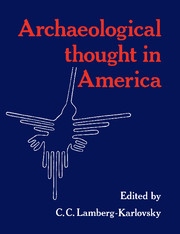Book contents
- Frontmatter
- Contents
- List of illustrations
- Introduction
- Part I History, method, and theory
- Part II Archaeology in the Americas and beyond
- 9 The structural analysis of Paleolithic art
- 10 Ancient China and its anthropological significance
- 11 Settlement pattern studies and evidences for intensive agriculture in the Maya Lowlands
- 12 The political economy of the Inka empire: the archaeology of power and finance
- 13 An epigenetic view of the Harappan culture
- 14 The use and abuse of world systems theory: the case of the “pristine” West Asian state
- 15 Mesopotamia, Central Asia and the Indus Valley: so the kings were killed
- 16 New tracks on ancient frontiers: ceramic technology on the Indo-Iranian Borderlands
- 17 Pastoralism and the early state in Greater Mesopotamia
- References
- Index
13 - An epigenetic view of the Harappan culture
Published online by Cambridge University Press: 06 July 2010
- Frontmatter
- Contents
- List of illustrations
- Introduction
- Part I History, method, and theory
- Part II Archaeology in the Americas and beyond
- 9 The structural analysis of Paleolithic art
- 10 Ancient China and its anthropological significance
- 11 Settlement pattern studies and evidences for intensive agriculture in the Maya Lowlands
- 12 The political economy of the Inka empire: the archaeology of power and finance
- 13 An epigenetic view of the Harappan culture
- 14 The use and abuse of world systems theory: the case of the “pristine” West Asian state
- 15 Mesopotamia, Central Asia and the Indus Valley: so the kings were killed
- 16 New tracks on ancient frontiers: ceramic technology on the Indo-Iranian Borderlands
- 17 Pastoralism and the early state in Greater Mesopotamia
- References
- Index
Summary
The Harappan civilization first became known during the early part of the twentieth century because of the discovery of two urban sites, Harappa and Mohenjo Daro, by the members of the Archaeological Survey of India. Its character was amplified by subsequent surveys and excavation by Majumdar (1934) and Mackay (1938:11, 1943). All of this work took place during the last years of the British Raj. In consequence, interpretations of the Indus civilization largely rested with the British archaeologists, Marshall (1931) and Mackay (1948). At the close of World War II and the departure of the British from rulership on the subcontinent, Wheeler (1953, 1968a), Piggott (1950b), Gordon (1958), and Childe (1952) (some of whose experience was of the Raj) were the new interpreters. From the very first discovery of the age and apparent character of the Indus civilization, starting with Marshall's clarion call to Mesopotamian archaeologists for help in identifying the time and relationships of the ancient culture, up to the death of Wheeler in 1975, the model used in representing the style of Harappan culture has been that of Near Eastern and Classical civilization. Thus Piggott wrote of a state with twin capitals. Childe described empire, and Wheeler's labels, such as “citadel,” “serried ranks of coolies,” evoked despotic monarchy.
- Type
- Chapter
- Information
- Archaeological Thought in America , pp. 205 - 217Publisher: Cambridge University PressPrint publication year: 1989
- 6
- Cited by



